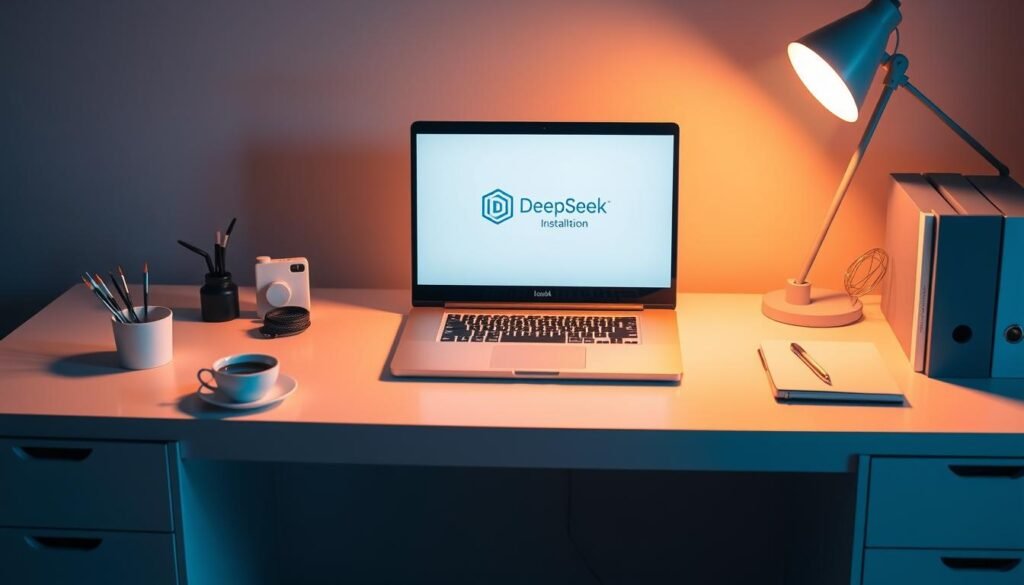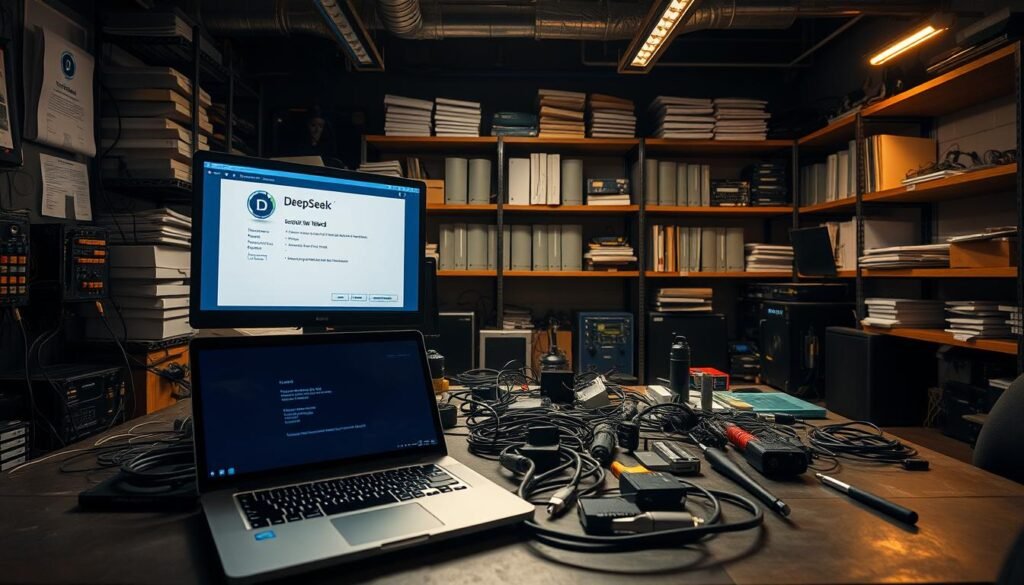Can you unlock the full power of AI by installing DeepSeek locally? What are the benefits of having DeepSeek on your own machine? This article will show you how to install DeepSeek locally in just 3 steps. You’ll learn how to set it up, run it, and use it in your projects. It’s all about following a simple guide.
Key Takeaways
- DeepSeek can be installed locally in 3 easy steps, following a deepseek installation guide.
- A local deepseek setup gives you full control over your data. It lets you try out different models easily.
- It’s great for developers, researchers, and AI fans. You can set it up with a deepseek installation guide.
- To install DeepSeek locally, you need to prepare your environment, download it, and run the setup. The guide will walk you through it.
- Setting up DeepSeek locally needs certain system requirements. You’ll need a good GPU and enough RAM. The guide will help you meet these needs.
- DeepSeek can be used in many projects. It’s a flexible tool for exploring AI models. You can install it using a deepseek installation guide.
- Installing DeepSeek locally lets you fully explore AI’s capabilities. The guide will show you how to do it.
What is DeepSeek and Why Use It?
DeepSeek is a strong open-source AI model. It’s great for complex tasks like coding, math, and solving problems. To install DeepSeek locally, you need to know its benefits. DeepSeek-R1 uses a special architecture that keeps performance high and efficient.
Using DeepSeek on your local machine gives you full control over your data. You can try out different models easily. By following DeepSeek setup instructions, you can install it smoothly. This makes it a great choice for developers and researchers.
DeepSeek can handle tough tasks like coding and math. It also shows how it makes decisions. With how to install DeepSeek locally being easy, you can dive into its amazing features.
DeepSeek is a powerful tool for AI exploration. Knowing its features and benefits helps you decide if it’s right for you. By installing DeepSeek locally, you can start exploring its capabilities.
System Requirements for Local Installation
To install DeepSeek locally smoothly, you need to meet certain system requirements. You’ll need a GPU with at least 24GB VRAM, a CPU with 8 cores, and 32GB of RAM. These are the deepseek local installation steps to follow.
The deepseek installation process also needs specific software. You’ll need Docker or Ollama. Knowing these requirements is key for a successful install and top performance.
Minimum Hardware Specifications
- GPU: 24GB VRAM
- CPU: 8 cores
- RAM: 32GB
Recommended Software Dependencies
Along with the right hardware, you need the right software. Docker or Ollama are essential for the deepseek installation process.
By following the deepseek local installation steps and meeting the system requirements, you can ensure a successful installation and optimal performance of DeepSeek. The steps to install deepseek locally are designed to be straightforward. With the right system configuration, you can start using DeepSeek in no time.
| Specification | Minimum Requirement |
|---|---|
| GPU VRAM | 24GB |
| CPU Cores | 8 |
| RAM | 32GB |
Step 1: Preparing Your Environment
To start the deepseek install locally, you need to get your environment ready. This means picking the right operating system and installing needed libraries and packages. A local deepseek setup needs careful planning to make the installation smooth.
Choosing an operating system is key. Ubuntu or Ubuntu-based systems are best for compatibility. Also, installing tools like Docker or Ollama can make the deepseek installation easier. These tools help you install and run DeepSeek without trouble.
Important things to think about for your environment include:
- Operating system compatibility
- Installation of necessary libraries and packages
- System requirements, such as RAM and disk space
By preparing your environment well, you can have a successful deepseek install locally. Following the deepseek installation guide and considering these points will help you start the installation right.

Step 2: Downloading DeepSeek
To start installing DeepSeek on your machine, first download the latest model version. The official repository is the best place to get DeepSeek. This ensures you have the newest and most reliable version. This step is key to a successful installation.
When you download DeepSeek, make sure your system can handle it. You’ll need a good CPU and GPU for the best performance. If your system is too small, you might run into memory problems. Downloading can take time, so be patient and keep your internet connection stable.
Where to Find the Latest Version
The official repository has the newest DeepSeek versions. You can find models like DeepSeek R1 with a billion parameters. There are also smaller models based on Qwen and Llama architectures. These models vary in size, from 1.5B to 671B parameters, to fit different systems and needs.
Verifying File Integrity
After downloading DeepSeek, check the file’s integrity. This is a critical step to ensure you have a genuine copy. It helps avoid problems during installation and use. By following these steps, you can download and verify DeepSeek smoothly, preparing for a successful installation on your machine.

For more details on installation and troubleshooting, check the official documentation and community resources. They offer detailed instructions and support for installing DeepSeek on your machine.
| Model Size | Parameters | Recommended Use |
|---|---|---|
| 1.5B | 1.5 billion | Personal computers with limited resources |
| 7B | 7 billion | Mid-range systems with moderate resources |
| 8B | 8 billion | Systems with dedicated GPUs and sufficient memory |
Step 3: Running the Installation Process
To finish the deepseek local installation, you must run the installation process. This means using the command line to execute the installation command. The process is simple, and by following the steps, you can install deepseek successfully.
The steps include running the installation command, dealing with common issues, and fixing any problems. It’s important to follow the instructions carefully to avoid mistakes.

- Checking the system requirements to ensure that your system meets the minimum requirements for the deepseek installation process
- Verifying the installation command to ensure that it is correct and properly formatted
- Troubleshooting any errors that may occur during the installation process
By following the steps and solving any issues, you can finish the deepseek installation. The process is designed to be easy, allowing you to start using deepseek quickly.
Post-Installation Configuration
After you’ve installed DeepSeek locally, it’s time to set it up to your liking. You’ll need to adjust settings, improve performance, and make sure everything runs smoothly. The guide on installing DeepSeek covers all the settings you can tweak, like choosing a model from a dropdown.
To make DeepSeek run better, you can tweak its size, batch size, and more. For example, using –chunk_size 512 can save memory on an A100 40GB GPU. The setup for DeepSeek locally also lets you use mixed precision (bfloat16) for speed and memory-efficient attention (flash_attention).
Here are some important settings to think about:
- Model selection: Pick from models like DeepSeek-VL2-Tiny, DeepSeek-VL2-Small, and DeepSeek-VL2, each with its own specs.
- VRAM requirements: Make sure your system has enough VRAM for the model you choose, like 16GB for DeepSeek-VL2-Tiny or 80GB for DeepSeek-VL2.
- CPU and RAM recommendations: For text tasks, use at least 16 cores and 16GB of RAM. For tougher tasks, consider 32+ cores and 64GB of RAM.
By following the guide and tweaking settings to your liking, you can make DeepSeek perform its best. Always check the official documentation for the latest on setting up DeepSeek locally and its options.
| Model Variant | Parameters | VRAM Requirements |
|---|---|---|
| DeepSeek-VL2-Tiny | 1.0B | 16GB |
| DeepSeek-VL2-Small | 2.8B | 40GB |
| DeepSeek-VL2 | 4.5B | 80GB |
Troubleshooting Common Issues
Starting with DeepSeek means you might face some problems. The first thing to do is check the log files. These logs can help you find out what’s wrong and fix it.
Having trouble installing? The DeepSeek community is here to help. Their forums and guides are full of tips from experts. With their help, you can get past any hurdles and set up DeepSeek without a hitch.
Success with DeepSeek comes from being open to learning. With the right tools and a supportive community, you’ll master DeepSeek in no time. Happy exploring!
FAQ
What is DeepSeek and what are its features?
What are the advantages of installing DeepSeek locally?
What are the minimum hardware specifications required to install DeepSeek locally?
How do I prepare my environment for installing DeepSeek locally?
Where can I find the latest version of DeepSeek and how do I verify its integrity?
How do I run the installation process for DeepSeek locally?
How do I configure DeepSeek after installation?
What are some common issues I might encounter during the installation process, and how can I troubleshoot them?
Source Links
- How to Install DeepSeek-R1 32B on Windows: System Requirements, Docker, Ollama, and WebUI Setup – https://dev.to/askyt/how-to-install-deepseek-r1-32b-on-windows-system-requirements-docker-ollama-and-webui-setup-37l4
- 🚀 How to Run DeepSeek LLM on Android: The Ultimate Guide (Does It Even Work?) – https://dev.to/koolkamalkishor/how-to-run-deepseek-llm-on-android-the-ultimate-guide-does-it-even-work-2n0h
- DeepSeek-R1: A Cutting-Edge Logical Reasoning Model for Local AI Development with Ollama 🚀 – https://medium.com/@pankaj_pandey/deepseek-r1-an-advanced-reasoning-model-for-ai-applications-using-ollama-0497a4899cb2
- DeepSeekAI’s Pocket-Sized Revolution: Running Open-Source 1.5B Model Locally – https://medium.com/@harshithaparitala1/deepseekais-pocket-sized-revolution-running-open-source-1-5b-model-locally-bb34082bddac
- How to Install and Run DeepSeek-V3 Model Locally on GPU or CPU – Fusion of Engineering, Control, Coding, Machine Learning, and Science – https://aleksandarhaber.com/how-to-install-and-run-deepseek-v3-model-locally-on-gpu-or-cpu/
- Dify x DeepSeek: Deploy a Private AI Assistant & Build a Local DeepSeek R1 + Web Search App – Dify Blog – https://dify.ai/blog/dify-deepseek-deploy-a-private-ai-assistant
- Official DeepSeek R1 Now on Ollama – https://news.ycombinator.com/item?id=42772983
- How to Install DeepSeek-R1 | phoenixNAP KB – https://phoenixnap.com/kb/how-to-install-deepseek
- DeepSeek Local: How to Self-Host DeepSeek (Privacy and Control) – https://linuxblog.io/deepseek-local-self-host/
- How to Run Deepseek R1 Locally Using Ollama ? – https://apidog.com/blog/run-deepseek-r1-locally-with-ollama/
- Run DeepSeek-R1 on Your Laptop with Ollama – https://dev.to/shayy/run-deepseek-locally-on-your-laptop-37hl
- How to Install DeepSeek Coder on AWS – https://www.linkedin.com/pulse/how-install-deepseek-coding-aws-meetrixio-xvhdc
- README.md · deepseek-ai/DeepSeek-V3 at 9672b384bf8a07c8968cf874cde35020f146fc64 – https://huggingface.co/deepseek-ai/DeepSeek-V3/blob/9672b384bf8a07c8968cf874cde35020f146fc64/README.md
- GitHub – deepseek-ai/DeepSeek-Coder: DeepSeek Coder: Let the Code Write Itself – https://github.com/deepseek-ai/DeepSeek-Coder
- Build Your Own Offline AI Chatbot: Running DeepSeek Locally with Ollama – https://medium.com/@shelwyncorte/build-your-own-offline-ai-chatbot-running-deepseek-locally-with-ollama-d8921c20bb53
- Mastering DeepSeek: Installing Tiny, Small, and VL2 Models with Inference and a Gradio Interface – https://nodeshift.com/blog/mastering-deepseek-installing-tiny-small-and-vl2-models-with-inference-and-a-gradio-interface
- LLM by Examples: Evaluate DeepSeek R1 by Llama.cpp and Open WebUI – https://medium.com/@mb20261/llm-by-examples-evaluate-deepseek-r1-by-llama-cpp-and-open-webui-70a0c3700f3f
- Runing DeepSeek R1 AI on Raspberry Pi is Easy : Complete Guide – https://www.geeky-gadgets.com/installing-deepseek-r1-ai-model-on-a-raspberry-pi/
